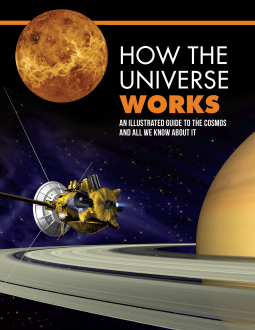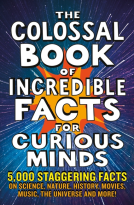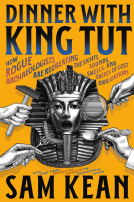
How the Universe Works
An Illustrated Guide to the Cosmos and All We Know About It
by Chartwell Books
This title was previously available on NetGalley and is now archived.
Send NetGalley books directly to your Kindle or Kindle app
1
To read on a Kindle or Kindle app, please add kindle@netgalley.com as an approved email address to receive files in your Amazon account. Click here for step-by-step instructions.
2
Also find your Kindle email address within your Amazon account, and enter it here.
Pub Date Oct 24 2017 | Archive Date Apr 24 2018
Quarto Publishing Group - Chartwell Books | Chartwell Books
Talking about this book? Use #HowTheUniverseWorks #NetGalley. More hashtag tips!
Description
The cosmos is a complex and intricate system that astronomers have been trying to dissect for years. From Galileo and Copernicus to the Space Race and Modern Day NASA missions, humanity has craved more knowledge about the universe and how it works. Hundreds of years of scientific discovery, and there’s still so much to learn. How the Universe Works is the latest installment in a series of books that deconstructs how things work and explains in a format that is easy to understand.
With beautiful and detailed visuals in the form of info-graphics, 3D illustrations, cutaways and renderings, How the Universe Works offers a tiny glimpse of the massive stretch of the universe. Each page delves more into the composition of the stars and shows the information in such a way that makes even the most complex phenomenons easy to understand. Learn how different cosmic bodies interact with one another, why, and how humanity has worked to understand space.
The observable universe spans billions and billions of light years. How the Universe Works is a work intended to put the cosmos in the hands of its readers. Understanding the most complex mechanisms that rule space is quite a task, but with information for the entire family, this editorial ally is perfect for getting immersed in the intricacies of the observable universe and all its natural beauty.
Available Editions
| EDITION | Other Format |
| ISBN | 9780785835417 |
| PRICE | $22.99 (USD) |
| PAGES | 256 |
Featured Reviews
Sometimes A Bridge Too Far
This is a fascinating and rewarding book, although sometimes it struck me that the authors were trying to do too much.
For example, the treatment of the solar system is excellent. There is a thorough and clear explanation of the basic structure of the system, and then of the sun and of each planet and how they all fit into the overall picture. On the other hand, the book actually opens with a description of the Big Bang and segues into a discussion of relativity, particular physics, and fundamental forces and elementary particles. While beautifully illustrated, if you don't already know most of the material I think the text would be too brief and cryptic to be of much value. And some of it is a bit random. There is a fine chapter on the geology of the Earth, but then a few pages on is "The Origin of Life" which tries to travel from prokaryotes to the present in 10 pages. A "History of Astronomy" also includes a two page spread on relativity and another on the Large Hadron Collider.
Even though it is not suggested by the title or set up by the first half of the book, the second half is where the narrative unexpectedly hits its stride. Opening with "The Space Race", we get an excellent recounting of early space exploration, manned flights, and the Apollo missions. This blends directly into an extended treatment of all of the current exploratory missions, with very nice chapters on each of the major planetary projects, as well as the deep space probes. I don't know if that falls under the heading "how the universe works", but it was still interesting.
Putting aside the oddly herky-jerky organization of the book, the volume really excels as a graphical introduction to all of these concepts and topics. It isn't just pretty pictures of planets and collections of Hubble photos. There are timelines, maps, detailed graphs, summaries and tabulations, and illustrations of various processes, that are powerful and effective educational tools. (Heck, there's a two-page spread of three dimensional models that show, to scale, Earth's closest star, galaxy and supercluster neighbors, that you could just study for half an hour.) The cross-section diagrams of the planets are amongst the best I've seen, and many of the pages have a definite "wow!" factor.
So, I thought this was interesting and educational. Some books are designed to be scalable, by which I mean a reader can start a chapter and the chapter gets progressively more demanding and complex as it goes on. The reader can pause once he's in over his head and move on to the next chapter, in which the process repeats. This book isn't like that. Both between chapters and within chapters the level of difficulty is constantly changing. There is much in the book for any level reader, and it might be that this is best approached as a browsable book, to be dipped into and out of. Viewed in that way, and maybe just on the strength of the graphics, this book delivered.
(Please note that I received a free advance will-self-destruct-in-x-days Adobe Digital copy of this book without a review requirement, or any influence regarding review content should I choose to post a review. Apart from that I have no connection at all to either the author or the publisher of this book.)
 Bill C, Reviewer
Bill C, Reviewer
Though not without some issues, How the Universe Works is generally an excellent reference work for a decently wide range of readers young to old (I’d guess it’s targeted at older teens and adults). Elementary school children will feel a little overwhelmed by some of the text, but the wonderful graphic: cut-away diagrams, timelines, etc. will provide them some clear and manageable info. Older young readers will follow the textual information better and the illustrations will serve as enhancement and clarification, while older readers who know some of this information will find the illustrations allow for better visualization while the text will serve as concise reminders.
Section One deals with cosmography, opening with a good visual “zoom out” to give a sense of our place in the universe, moving from the solar system to nearby stars, the local groups, etc. We then get a timeline of the universe’s creation and what we think happened in those first few moments (creation of matter, the basic forces, inflation, and so on) followed by some theories on how the universe will end. And then we bore in more detail in the Milky Way and other galaxies, and then different types of stars and how they form and how they’ll end. This first section is tough in that the authors are trying to cover an awful lot in a short period of time: particle physics, stellar physics, the basic forces, and I think they don’t quite nail it, with things feeling a bit random/choppy and I would imagine more than a little hard to follow if one doesn’t already know some of the above. If I were reading this with younger kids, I’d probably skip this part and come back to it. Even the stellar physics, which is less wide-ranging, has a lot going on with its diagrams and charts and arrows and it might all be overwhelming.
Things become more clear and concrete in section two, dealing with the solar system, a more narrow topic that allows the book to really find its pace and place. The cutaway diagrams of each planet are fantastic, as are illustrations of orbits, magnetic fields, and ring systems. Here the visuals don’t overwhelm but clarify, and in many ways act as better guides to the information than the text, as when one considers for instance the layered elements of each planet, such as the atmosphere or the inner core. Each planet also gets a table of “essential data” which is just what one would expect—facts such as orbital speed, number of moons, orbital year, average temperatures, etc. Other parts of the solar system covered are dwarf planet Pluto, asteroids, comets, Kuiper Belt Objects, the Oort Cloud. This section closes with a look at other solar systems, with an excellent timeline of extra-solar planet-finding, along with some descriptions of interesting examples, including a very up-to-date discussion of the Trappist planets.
The third section looks in detail at the Earth and moon, with again some wonderful cut-aways of the planet rocky parts from the surface to the core, the layers of the atmosphere above the surface, and the Earth’s magnetic field. There’s an excellent explanation—textual and visual—of how the moon affects our tides in the segment on the moon. After some more information on the moon, we return to the Earth for a timeline of the geological and biological evolution of the planet, including mineral creation, the rock cycle, the origin of life (including a discussion of panspermia), the Cambrian Explosion and a nicely clear phylogenetic tree diagram showing the interrelationships of all life.
Much to my pleasant surprise, based on the cover and title, we then move into sections dealing with humanity’s exploration of the cosmos, beginning with the history of astronomy, including a fascinating reconstruction of Su Song’s astronomical clock from Ancient China. More contemporary technologies discussed include the Large Hadron Collider and the Ver Large Array.
Chapter Five details the space race through the Apollo missions. Chapter Six covers explorations beyond the moon, which begins with several pages of, again, nicely clear explanations of rocketry that include types of engines, launch pads, launch windows, and more. Then it’s on to the space shuttle and space station, then space-based observatories such as Chandra and Hubble. Moving from general to specific, Chapter Seven goes into detail on planetary missions/probes, spending a lot of time on the various Mars missions and the sundry orbiters and rovers, then goes on to look at other planetary missions such as Galileo, Cassini, and again showing up pleasingly up to date they are, the New Horizons mission to Pluto. The visuals range from trajectory paths of arrival to explanations of the probe’s parts, to nicely informative explanations of landing methods, such as the crane release of the Mars rover. Finally, the last section is sort of a hodge-podge if space technology, ranging from GPS satellites to space tourism, to the perils and possible solutions of space junk/debris.
Every now and then a visual in the book is perhaps over-complicating rather than clarifying, there can at times be a bit of a random feel to the organization, and as noted earlier, some of the information is certainly overwhelming for younger readers. But those are minor quibbles in a book that overall does a nice job of meshing text and visuals so that each enhances the other to clearly convey information for each of comprehension and retention.
Beautiful book but covers too much
This book is interesting and fun to read, and does a great job of covering history, such as the space race or history of astronomy. And the illustrations are beautiful. But too much of the book is spent on things other than explaining the cosmos. And when discussing the cosmos, it is weak at explaining certain phenomena, thus prior knowledge is required to understand some of the material. One of the irritants was that the content on any one page wasn't always well organized. But overall it was still worth reading.
Disclosure: I received a complimentary copy of this book via Netgalley for review purposes.
Readers who liked this book also liked:
Nigel Henbest; Simon Brew; Sarah Tomley; Ken Okona-Mensah; Tom Parfitt; Trevor Davies; Chas Newkey-Burden
Entertainment & Pop Culture, Humor & Satire, Nonfiction (Adult)



















